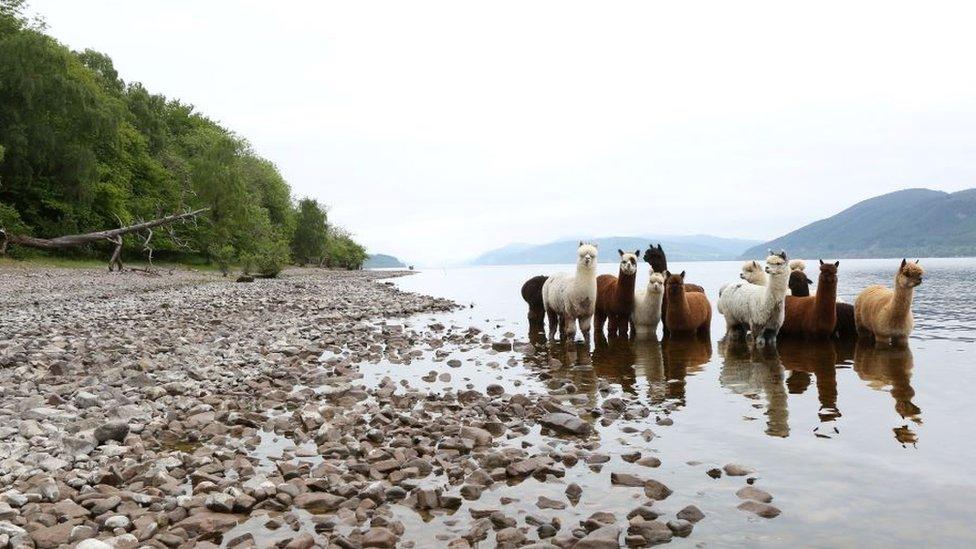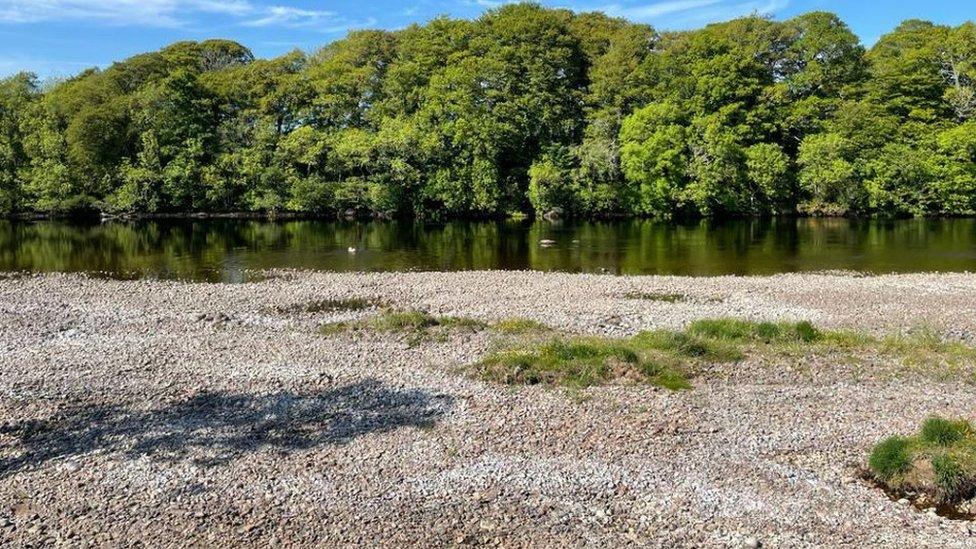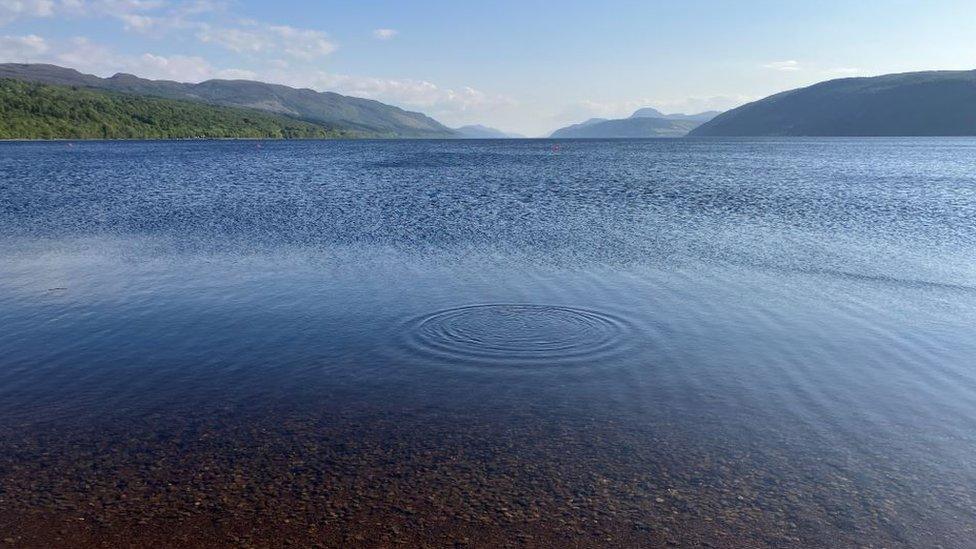Concerns over Loch Ness' falling water levels
- Published

Alpacas from Loch Ness Alpacas near Dores cooling off at the loch earlier this week
Concerns have been raised over water levels on Loch Ness and the River Ness.
The loch dropped to its lowest level in 32 years last month amid dry conditions, according to Scottish Environment Protection Agency figures.
Ness fishery board said levels remained concerningly low and claimed water that could help ease the situation was being stored - unused - for hydro-power.
Energy company SSE Renewables said it was managing its water use sensitively amid challenging weather conditions.
Loch Ness is Scotland's largest freshwater loch by volume, while the River Ness flows from Loch Dochfour, at top of Loch Ness, and out to sea at Inverness. The loch and river are part of what is called the Ness system, an area of burns, rivers and lochs that extends south-west of Inverness.
On 24 May, Scottish Environment Protection Agency (Sepa) recorded a water level of just over 109cm (3.5ft) at Foyers, which is the location of a pumped storage hydro scheme that uses water from Loch Ness. Water is pumped from the loch to an upper reservoir and released back when generating electricity.
The Sepa figure is the lowest level according to records going back to 1 December 1990. It has risen slightly since, but continues to be classed as "low".
Sepa said the area had seen low rainfall.
It said in May the Loch Ness area had been one of the driest in the UK, and Inverness had received just a third of its usual long-term average rainfall.
It added the Ness region had seen below average rainfall in winter and spring. On Friday, external, the agency increased its water scarcity warning for the area to "moderate".
Sepa also upgraded the risk in the Loch Maree area in the Highlands to "significant", and placed 37 areas across the Firth of Clyde at "alert".

Ness fishery board said the River Ness had hit record lows twice this year

The River Ness, left, and Caledonian Canal at Dochfour

Concerns have been raised about the health of the Ness
Ness District Salmon Fishery Board, the statutory body responsible for the protection and enhancement of salmon and sea trout fisheries in the Ness area, has expressed serious concerns about the health of the River Ness.
It said the river was at levels more usually seen at the end of July and August, with large areas drying out.
Director Brian Shaw said there were consequences for wild salmon populations, the river's conservation status and its categorisation in terms of angling.
Problems include salmon being unable to travel easily up river from the sea, and increased water temperature.
Mr Shaw said climate change was a factor, and the board had noted a trend for drier winters and springs.
But he said when levels were low, hydro-electric generation had a huge effect. Mr Shaw also said water was drawn at Dochfour for the Caledonian Canal that would otherwise flow into the River Ness.
"There is a tremendous amount of concern and I think one of the key things is we are so early in the summer and already twice the River Ness has got to its lowest level on record, said Mr Shaw.
He added: "Most people wouldn't appreciate just how controlled the Ness system is.
"When it gets down to these low levels almost every aspect of it is controlled by hydro schemes on the system."
He said releasing water stored further up the system at SSE's Loch Garry and Loch Loyne reservoirs could help alleviate the situation.

Naturalist Adrian Shine said Loch Ness was at the lowest he had seen since 1989
Naturalist Adrian Shine, who has studied Loch Ness for many years, said the loch was at its lowest level he had seen since 1989.
He said: "Loch Ness is very deep so you are not going to see an immense difference over its surface and the sides are very steep, except in certain areas.
"The most noticeable area is Urquhart Bay and there is a bay within that bay that is dry, and I don't remember that happening in '89."
Fiona Cairns, who has lived by the loch for most of her life and runs Loch Ness Alpacas, also said it was at the lowest she had ever seen it.
She said her cheeky alpacas were able to sneak into their other field by going around the end of fences usually inaccessible due to the depth of the loch.
"We've had very little rain over the last few weeks and the burns are dry so not filling the loch," she added.

Loch Ness is Scotland's largest freshwater loch by volume
SSE Renewables said the dry weather had affected rivers across the Highlands.
A spokesperson said: "While these dry conditions are challenging, our teams have been working closely with key environmental stakeholders such as Sepa and NatureScot to manage our hydro operations in accordance with our environmental obligations, while continuing to deliver zero carbon electricity from our hydro and pumped storage assets."
The spokesperson added that sensitive management of water had helped maintain higher flows in the River Ness than would have been present if hydro-power was not in existence, while at the same time maintaining levels at lochs Loyne and Garry to protect designated nesting sites of protected birds.
Scottish Canals said water levels were at an unprecedented low due to the weather.
Environment manager Olivia Lassiere said: "We anticipate more instances like this occurring going forward, due to the likely impacts of climate change.
"Our water usage and operation of the Caledonian Canal is authorised and regulated by Sepa, and we have robust plans in place to manage extreme situations like this, which include engaging with Sepa for their latest advice."